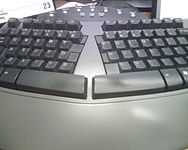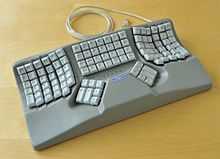Ergonomic keyboard

An ergonomic keyboard is a computer keyboard designed with ergonomic considerations to minimize muscle strain and a host of related problems.[1] Typically such keyboards for two-handed typists are constructed in a V shape, to allow right and left hands to type at a slight angle more natural to the human form.
Types



Split Keyboard
A "fixed-split keyboard" is a single board, with the keys separated into two or three groups, allowing the user to type at a different angle than the typical straight keyboard.
An "adjustable split keyboard" has the keyboard split into several independent pieces, so the angle between them can be easily changed.
Contoured Keyboard

A further development of the split concept are contoured keyboards like the 1977 Maltron or the newer Kinesis Advantage line, which place the keys into two depressions set approximately at shoulder width, with function keys set between the key groups for use with the thumbs. In this configuration, very little movement of arms and wrists is required.
Handheld Keyboards
Handheld ergonomic keyboards are designed to be held like a game controller, and can be used as such, instead of laid out flat on top of a table surface. They allow the user the ability to move around a room or to lean back on a chair while also being able to type in front or away from the computer.[2] Some variations of handheld ergonomic keyboards also include a trackball mouse that allow mouse movement and typing included in one handheld device.[3]
Angled Split Keyboard
The angled split keyboard (sometimes referred to as a Klockenburg keyboard) is similar to a split keyboard, but the middle is tented up so that the index fingers are higher than the little fingers while typing. Key Ovation makes the Goldtouch ergonomic keyboard which is an adjustable angled split keyboard.
Other Ergonomic Keyboards
Other ergonomic keyboards have fixed, vertically aligned keys, so the user types with their hands perpendicular to the ground, thumbs-up. Still others allow a range of rotation and elevations. A few ergonomic keyboards do not have the typical one key per letter, such as a keyer or a keyless ergonomic keyboard.[4] Datahand eliminates the need for any wrist motion or finger extension.
Considerations
Advantages
An ergonomic keyboard may reduce muscle strain and reduce risk of carpal tunnel syndrome[5][6][7] or other kinds of repetitive strain injury, but there is no clear evidence of benefit.[8] Manufacturers claim ergonomic keyboards reduce injuries, and that after a user takes the time to adjust to this style of keyboard, they can help reduce strain and increase typing speed.
Disadvantages
Ergonomic keyboards are often marketed as premium equipment, with according features and software, and pricing. For a full featured mechanical keyboard, including adjustable splits, prices can be around $250, while some high-end sets cost many hundreds more. Simple ergonomical keyboards with no additional features are available in the lower price range, their average cost only slightly exceeding conventional non-shaped keyboards of comparable production quality.[9]
References
- ↑ Michelle Magnan (April 5, 2007). "Blueprint for a healthy workstation". The Calgary Herald. Retrieved 2007-04-20.
- ↑ http://alphagrips.com/comfort.html
- ↑ http://alphagrips.com/WhitePaper.html
- ↑ orbiTouch keyless ergonomic keyboard
- ↑ http://www.maltron.com/keyboard-info/academic-papers/235-keyboards-designed-to-fit-hands-and-reduce-postural-stress.html
- ↑ http://www.maltron.com/keyboard-info/academic-papers/234-a-keyboard-to-increase-productivity-and-reduce-postural-stress.html
- ↑ http://www.maltron.com/keyboard-info/academic-papers/233-computer-related-upper-limb-disorder.html
- ↑ Fagarasanu, M., Kumar, S. Carpal Tunnel Syndrome due to keyboarding and mouse tasks: A review. International Journal of Industrial Ergonomics, 2003, 31 (2), pp. 119-136.
- ↑ http://www.microsoft.com/hardware/en-us/p/natural-ergonomic-keyboard-4000